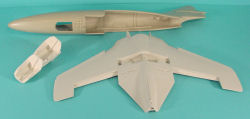
Fisher Model and Pattern 1/32 TF-9J (F9F-8T) TF-9J (F9F-8T) Cougar First Look
By Michael Benolkin
| Date of Review | July 2007 | Manufacturer | Fisher Model and Pattern |
|---|---|---|---|
| Subject | TF-9J (F9F-8T) Cougar | Scale | 1/32 |
| Kit Number | 3203 | Primary Media | Resin/Photo-Etch |
| Pros | Another magnificent resin release - no casting blocks, no pinholes, near-perfect fit! | Cons | Nothing noted |
| Skill Level | Intermediate | MSRP (USD) | $195.00 |
First Look
 |
 |
 |
 |
 |
 |
 |
The F9F was a transitional aircraft for Grumman. With the Panther, Grumman produced its first carrier-based jet fighter, but it retained straight wings. The Cougar took the experience of the Panther and added swept wings to give it better speed. With the shape of the wings and wing root fairings, the Cougar gained additional wing area which provided better lift and low-speed handling.
The two-seat F9F-8T (TF-9J) Cougar would become Grumman's first trainer derivative from one of its fighter series. Finally, the Cougar would be the first to employ a new weapon of the era, the guided missile, with the installation of the first Sidewinders.
The F9F Cougar entered service too late to see combat in Korea (though it made it into theater just as the treaty was signed) and left service too early for Vietnam, though a few TF-9J trainers were pressed into Forward Air Control (FAC) duties early in that war.
Fisher Models released this beauty after their F9F-5 Panther and F9F-8 Cougar kits, filling another interesting hole in the Grumman cat line-up. In its original designation, the F9F-8T Cougar (sometimes nicknamed the 'Twogar') provided an essential instructional airframe to teach the still-fledgling jet-powered naval aviators how to safely operate this high performance (for the day) aircraft from shore as well as from the carrier.
Despite the importance of the two-seaters in aviation history, for some consumer perference reasoning, two-seat trainers have a history of awful sellers in the hobby industry. Never mind that many of these two seaters would go on to become important combat aircraft of their own right. In the case of the Twogar, this turned out to be an ideal airframe for conducting high-speed Forward Air Control (FAST FAC) duties in the early days of Vietnam.
Two sets of eyes in the FAC platform allowed the observer to keep his eyes on targets that are difficult to re-aquire should one be forced to look away as is the case with single-seat FAST FAC aircraft. A pilot must periodically scan the skies and instruments in order to keep from flying into something (like the ground) or missing the tracer fire that might be seeking him out.
As with the previous F9F releases from Fisher Models, this kit is cast in resin and is a masterpiece. Take a look at those parts, you'll find very few casting blocks on these parts and the fit is nearly perfect out of the box. The first photo illustrates the two-place cockpit tub inside the hollow-cast one-piece fuselage as well as the fuselage sitting nicely atop the one-piece wing. This is about as close to a resin snap-tite kit as you'll find.
The flaperons and elevators are separately molded and are positionable as you'd like. Assembly of the horizontal stabilizers to the tail section is identical to a styrene kit, you just can't use liquid styrene cement for assembly. Cyano-type glues are the best choice for this project.
The kit provides you two types of ejection seats, the early Grumman seats and the later Martin-Baker seats. Look how thin those cockpit sidewalls are cast! They're the thin parts sitting in front of the ejection seats.
As a trainer, the Twogar may carry external tanks and occasionally other weapons types for familiarization training. These include the two Sidewinder missiles that armed the operational Cougars. This kit also provides four rocket pods as used by the FAST FAC to mark targets in order to orient strike aircraft as they enter the target area.
Markings are provided for six examples:
- TF-9J, 147393, TM/3, H&MS-11, USMC FAST FAC, Vietnam
- F9F-8T, 147382, NJ/620, VF-126, USN
- F9F-8T, 142473, SD/302, VMT-10, USMC
- F9F-8T, 146412, 3L/633, VT-26, USN
- F9F-8T, 147413, -/413, NAS Atsugi
- F9F-8T, 147404, Blue Angel 7, 'Beetle Bomb'
What's the different between an F9F-8T and the TF-9J? 1962. Prior to 1962, each service had its own designation system for an aircraft. F9F indicated a Fighter, ninth type from the manufacturer, and the third letter denotes that manufacturer - F = Grumman. The post-dash designations indicate the eight variant of the design and the T indicates trainer. After 1962, the F9F simply became the F-9 and the F9F-8T was translated into TF-9J. In contrast, the McDonnell Douglas F4H-1 was the USN designator for the first production Phantom II while the USAF was considering the aircraft for their own use and designated it the F-110. After 1962, all the services recognized the aircraft as the F-4 Phantom II.
This is a magnificent kit that will build into a show stopper. While some people may be put off by the retail price, remember that a 1/32 Trumpeter styrene kit isn't much cheaper than the Fisher line of resin aircraft. Whether you opt for this beautiful two-seater, the single-seat F9F-5 Panther or the F9F-8 Cougar, or even the upcoming F9F-2 Panther, you won't find a more accurate and beautifully detailed kit of this aircraft in any scale.
This one is definitely highly recommended!
I bought my kit directly from Fisher Model and Pattern.







